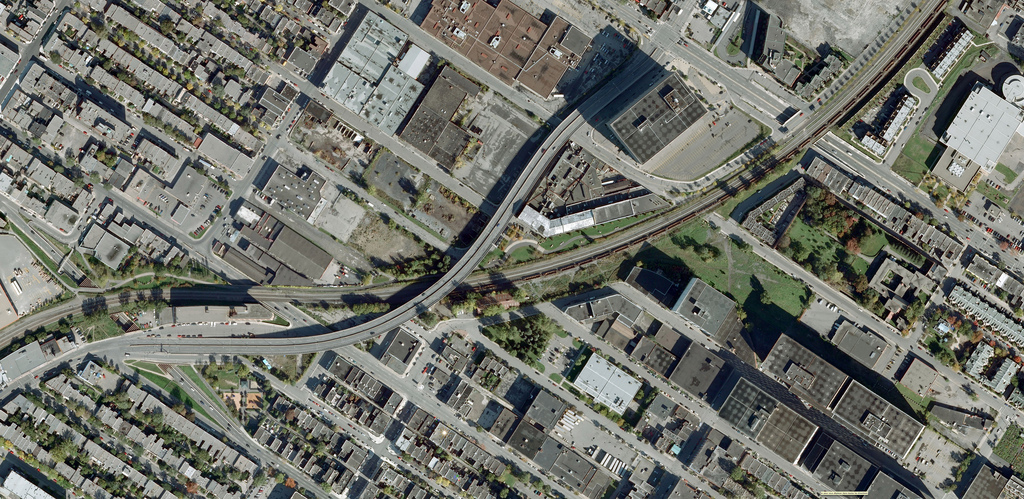Description:
Champ des Possibles is a natural green space located in Mile End (within the Plateau-Mont-Royal borough) that is jointly managed by citizens dedicated to protecting their neighborhood since 2007. Previously, it was a yard belonging to the Canadian Pacific Railway until the end of the eighties but nature has since gone wild at the site, and we are now able to count some 300 plant and animal species, including skunks, foxes and peregrine falcons. Local residents are gradually appropriating this industrial wasteland, most notably by constructing vegetable gardens, organizing concerts, as well as cleaning and maintaining the plot. [1]
Strong citizen support for the Champ des Possibles was born from the meeting of various visionaries at the end of the 2000s, including: an expert in urban biodiversity who was already surveying the site for his own research in natural history; an artist who was intrigued by this plot in the middle of a universe dominated by concrete; and above all a community of residents and workers in love with this quite unique green and wild space who decided to oppose the City of Montréal, who intended to replace it with a “truck yard”.
The naturalist Roger Latour, a community of biologists and horticulturalists as well as other “maniacs" of ecology and design quickly came to the defense of the ecological and social value of the Champ des Possibles and other abandoned post-industrial sites. They argued that such forgotten and abandoned places hold great potential for the protection and development of urban biodiversity and ecological services, which could benefit residents, wildlife and communities alike. In addition, the neighbors and activists made it clear that all of these sites are of value to the community, arts and culture. [2]
The challenge of the Champ des Possibles is to put people in contact with nature, close to where they live. It succeeds in protecting and increasing the biodiversity present in the neighborhood, making secondary that it is also a place for humans. There are many indications that biodiversity and cultural diversity are much more interdependent – if not absolutely necessary for their mutual growth – than most people believe. [3]
References:
[1] “Champ Des Possibles.” WWF.CA, June 2, 2020. https://wwf.ca/biopolis-projects/champ-des-possibles-2/.
[2] “À Propos.” Les amis du champ des possibles, December 10, 2018. https://champdespossibles.org/a-propos/.
[3] “Biodiversité.” Les amis du champ des possibles, June 7, 2018. https://champdespossibles.org/biodiversite/.
Additional information:
Hammond, Cynthia Imogen. “The Possible, 2014.” Cynthia Imogen Hammond, March 12, 2021. https://cynthiahammond.org/2014/12/08/the-possible-2014/.
“Le Plateau-Mont-Royal Se Dote d’Un Espace Naturel Protégé : Le Champ Des Possibles .” Le Plateau Mont-Royal, n.d. http://ville.montreal.qc.ca/pls/portal/docs/PAGE/ARROND_PMR_FR/MEDIA/DOCUMENTS/SVE_CHAMP_POSSIBLES.PDF.
“RAPPORT D’ACTIVITÉS 2020.” le champ des possibles. les amis du champ des possibles, n.d. https://champdespossibles.org/wp-content/uploads/2020/12/RapportActivite2020.pdf.
“Secteur Saint-Viateur Est.” Montréal. Accessed July 15, 2021. https://ville.montreal.qc.ca/portal/page?_pageid=7297%2C112003646&_dad=portal&_schema=PORTAL.
Shapcott, Mel. “The Roerich Garden Project.” Emily Rose Michaud, June 9, 2015. http://emilyrosemichaud.com/2015/06/the-roerich-garden-project.html.
Project Title: Champ des Possibles
Artists: Les Amis du Champ des Possibles
Year: 2013
Place: Montréal, Québec
Activism, Art, City, Collaborative, Completed Projects, conservation, Exhibit, Functional, Gallery, Landscape, Montreal, Multi Use, Nature, Outdoor, Park, Partnership, Permanent, Play, Public, Sculpture, Urban





